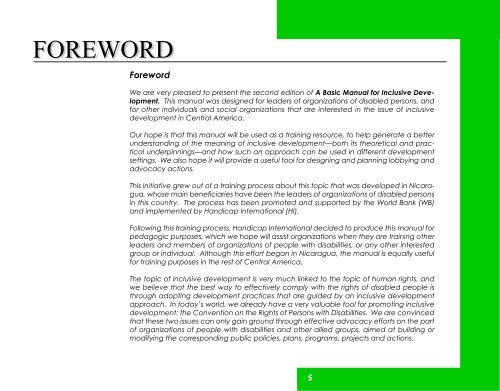in English - Handicap International
in English - Handicap International
in English - Handicap International
You also want an ePaper? Increase the reach of your titles
YUMPU automatically turns print PDFs into web optimized ePapers that Google loves.
FOREWORD<br />
Foreword<br />
We are very pleased to present the second edition of A Basic Manual for Inclusive Development.<br />
This manual was designed for leaders of organizations of disabled persons, and<br />
for other <strong>in</strong>dividuals and social organizations that are <strong>in</strong>terested <strong>in</strong> the issue of <strong>in</strong>clusive<br />
development <strong>in</strong> Central America.<br />
Our hope is that this manual will be used as a tra<strong>in</strong><strong>in</strong>g resource, to help generate a better<br />
understand<strong>in</strong>g of the mean<strong>in</strong>g of <strong>in</strong>clusive development—both its theoretical and practical<br />
underp<strong>in</strong>n<strong>in</strong>gs—and how such an approach can be used <strong>in</strong> different development<br />
sett<strong>in</strong>gs. We also hope it will provide a useful tool for design<strong>in</strong>g and plann<strong>in</strong>g lobby<strong>in</strong>g and<br />
advocacy actions.<br />
This <strong>in</strong>itiative grew out of a tra<strong>in</strong><strong>in</strong>g process about this topic that was developed <strong>in</strong> Nicaragua,<br />
whose ma<strong>in</strong> beneficiaries have been the leaders of organizations of disabled persons<br />
<strong>in</strong> this country. The process has been promoted and supported by the World Bank (WB)<br />
and implemented by <strong>Handicap</strong> <strong>International</strong> (HI).<br />
Follow<strong>in</strong>g this tra<strong>in</strong><strong>in</strong>g process, <strong>Handicap</strong> <strong>International</strong> decided to produce this manual for<br />
pedagogic purposes, which we hope will assist organizations when they are tra<strong>in</strong><strong>in</strong>g other<br />
leaders and members of organizations of people with disabilities, or any other <strong>in</strong>terested<br />
group or <strong>in</strong>dividual. Although this effort began <strong>in</strong> Nicaragua, the manual is equally useful<br />
for tra<strong>in</strong><strong>in</strong>g purposes <strong>in</strong> the rest of Central America.<br />
The topic of <strong>in</strong>clusive development is very much l<strong>in</strong>ked to the topic of human rights, and<br />
we believe that the best way to effectively comply with the rights of disabled people is<br />
through adopt<strong>in</strong>g development practices that are guided by an <strong>in</strong>clusive development<br />
approach. In today’s world, we already have a very valuable tool for promot<strong>in</strong>g <strong>in</strong>clusive<br />
development: the Convention on the Rights of Persons with Disabilities. We are conv<strong>in</strong>ced<br />
that these two issues can only ga<strong>in</strong> ground through effective advocacy efforts on the part<br />
of organizations of people with disabilities and other allied groups, aimed at build<strong>in</strong>g or<br />
modify<strong>in</strong>g the correspond<strong>in</strong>g public policies, plans, programs, projects and actions.<br />
5

















